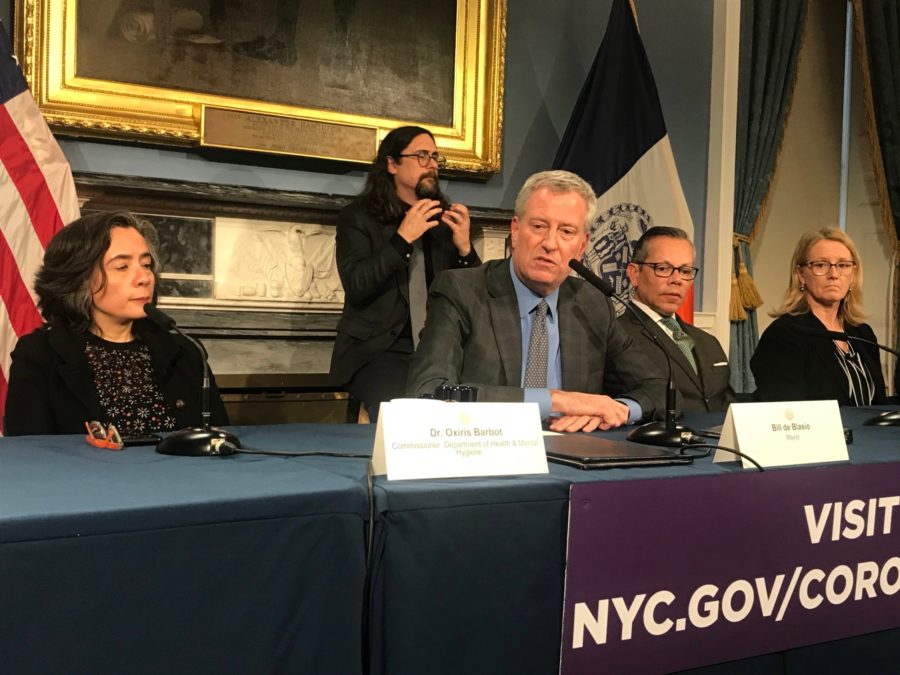3/9 – 20 Cases: On Tuesday morning, the day after De Blasio stated mass closures are not on the menu, I got a call from a student Michelle, who I thought was calling to thank me for finding her iPhone charger last week. She was calling because her mother has a health condition and is worried about Michelle bringing COVID-19 home. Any other day I would remind Michelle that graduation is around the corner in hopes of nudging her to push past the fear to come to school. Offering this kind of tough encouragement didn’t seem appropriate when the threat is very real. While I searched for words, I realized that I really can’t guarantee that she wouldn’t get sick at school or during her commute, and I also didn’t know how to guarantee she could finish what she needed to graduate. We finished our conversation and I began looking through my plans for the next few weeks of classes and started trying to imagine how kids could finish a multi-part project online, so I’ll be ready when other students like Melissa make the same decision.
As a teacher, I plan activities that stretch out over weeks each cycle. I’ve built big projects and planned ways students interact and collaborate as they learn. The eerily empty class I taught Tuesday, left me with stacks of unused worksheets, hollow discussions, and the question of how what could be translated to an online session for students who couldn’t be there. Unlike usual absences, I can’t assume that students are going to rejoin the class in a day or two. My whole approach to planning for their learning would change. At the same that my teaching is morphing into a dual and remote learning, there doesn’t seem to be any forgiveness in what is expected. Graduation dates, state testing dates, and the consequences our schools and our students face for underperforming haven’t changed, which adds considerable weight to any changes we are considering. If schools were to shut down, I could focus on making the most of this different model, but until then it’s like the captain of a sinking ship having to make sure every students in the water can get a life preserver while also having to bail water and keep the boat afloat for the students who are still on board.
3/11 – 44 Cases: A student was huddled around my desk arousing enough suspicion for me to jokingly ask, “Hey, what are you doing?” They turned around and I saw the student using my desk size hand sanitizer dispenser to fill up their portable container. “I ran out and nobody had any so I figured I filled up.” I wanted to be able to joke in that moment as humor is the bedrock of all of my student relationships, but I couldn’t hide the genuine concern that flashed across my face. The student stopped pumping. “My bad, but don’t worry, you have enough and I have enough.” They capped their 3/4 full container, and I replied. “Thanks. Don’t worry we just ordered more.” We laughed nervously, and I hoped that our school’s order isn’t delayed.
Perhaps the first job of schools is to provide a safe place for children and that is also difficult. Our school has been running out of supplies like hand sanitizer, and cleaning wipes, and our vendors are out of stock. The supply we need is a Coronavirus test, but those are unobtainium at this point. New York isn’t providing fast testing for the virus, so no one in the school can say they are not infected or contagious, even if they are symptom-free. De Blasio has said children aren’t “at high risk”, but children can get sick and infect their loved ones, even if they have washed their hands and sanitized their laptop. If we can’t ensure that schools won’t be places to spread the infection, then we are imposing suffocating anxiety and perhaps deadly harm for the vulnerable people who need those schools services.
3/12 – 95 Cases: On Thursday we had a student who had to go to the hospital. A typical teenage injury, that requires a member of school personnel to travel with EMS to the hospital and wait in the ER until the parents arrive. As I typically help the nurse figure out who should go, I went down the phone list to see who could help the student I kept hesitating. “They are pretty old, so is that person, and they have pre-existing conditions. What if they sit next to a person with COVID-19 who is waiting to be assessed?” As the disease spreads, the closer it gets to the school. Today’s routine trip the hospital feels like Russian roulette, and the emotional labor is palpable. Someone agreed to go, but I felt really bad about it. Their close friend is pregnant. “I’ll be fine, right?” they asked. I froze, my hesitation providing my answer. Luckily I got a text that the nurse found someone else to go. We both shared a deep sigh and exhaled most of the anxiety.
As an administrator and a teacher, I also have to support all the school staff. The emotional tension of trying to make learning happen amid all of this uncertainty is increasing in proportion with NYC’s growing number of COVID-19 cases. It is hard to have a safe learning experience when we don’t know that everyone isn’t going to get sick, or isn’t already sick. NBA player Rudy Gobert looked perfectly fine playing basketball, and showed no symptoms, despite testing positive and infecting others. Sustaining morale is a serious job, as this situation is wearing on the mental health of everyone in the school community. Lots of daily operations are now fraught with more emotional weight making the day really hard. Also making the days hard is the lack of change in what our charge is. We worked hard making to get students to graduate, and as our plans are impacted more each day, we have yet to hear calls for schools to have time for more long-term planning. The future is also lacks clarity around standardized assessment expectations, and school accountability metrics, as each day sees our goals become more and more unrealistic. If meeting the needs of the vulnerable populations is important, we need to acknowledge that meeting everyone’s needs just became much more difficult, and we need time to adjust, not a mandate to stay the course.
3/13 – 154 Cases: Friday’s staff meeting involved getting ready for an unclear future. I lead a quick session about putting information for students’ classes online and then tried to field questions. “What about students who can’t get online? Can we give them the computers from our laptop cart? Will having those laptops make them a walking target?” It was quickly clear that we didn’t have time to answer the questions around how to support learning while also having the added burden of finishing the meeting with time to prepare for class. After we broke I talked with one teacher who already had their stuff online. They were planning to use their sick days to stop coming to work because they didn’t want to risk coming in. I tried to convey that doing so is the right choice is for them, and for the larger effort of stopping the spread of the virus. Mentally, I add another name to our coverage list, including a teacher who has to pick their child up from college.
De Blasio said that schools are being kept open to provide social services for our most vulnerable students. The meals, medical services, and child care are important for a population of people who may need to continue working through any possible shutdown. The schools that we have designed to do a great job of that during the school year with a regular population. With a growing portion of the student population choosing to stay home, and with staff members as well needing to stay home as well, our schools are quickly becoming poor facsimiles of the institutions that are an important part of the social safety net. Schools do a very important job, but that isn’t the job that we can do right now because of the reality of this situation. Right now we staff have to face our own lives, which are changing dramatically outside of school. Inside school, we have to face uncertainty about whether we are safe because we don’t know about the nature of the disease, and whether our safeguards are going to be enough. We are also figuring out how to run a remote learning operation for all the students who aren’t there, while trying to adjust the learning experience for the students who are still coming.
3/15 269 Cases: I partially my name to the coverage list, as my daughter’s daycare closes for two weeks. My wife and I will have to split time between caring for our two year old, and working at our respective schools.
As I’m sitting down to think about the upcoming week, I can’t help but worry about our school’s ability to do the things the Mayor envisions. If we have to create a new educational method on the fly, while also fearing for the health of us and our loved ones, in a country facing shortages of supplies like masks and hand sanitizer, it makes sense to admit that we aren’t able to serve the role and find other ways to ensure that our most vulnerable populations get their needs met. The summer school model, or the emergency model of schools could work in the short term while teachers figure out how to best help the students who are not coming to school. For students who aren’t coming to school, let’s not demand that they come to school until we can ensure their safety, meaning having stocks of supplies and also having more testing, and faster testing available for all, not just celebrities. None of us are trained to manage an ongoing crisis. We’re here to help students learn, but going into a school where you fear for your health and the health of your loved ones and your students, isn’t a good place for learning. Let’s close the schools, and let the teachers try their hand at remote learning until we can ensure that the environment is safe enough for us to do our job.


Leave a Reply